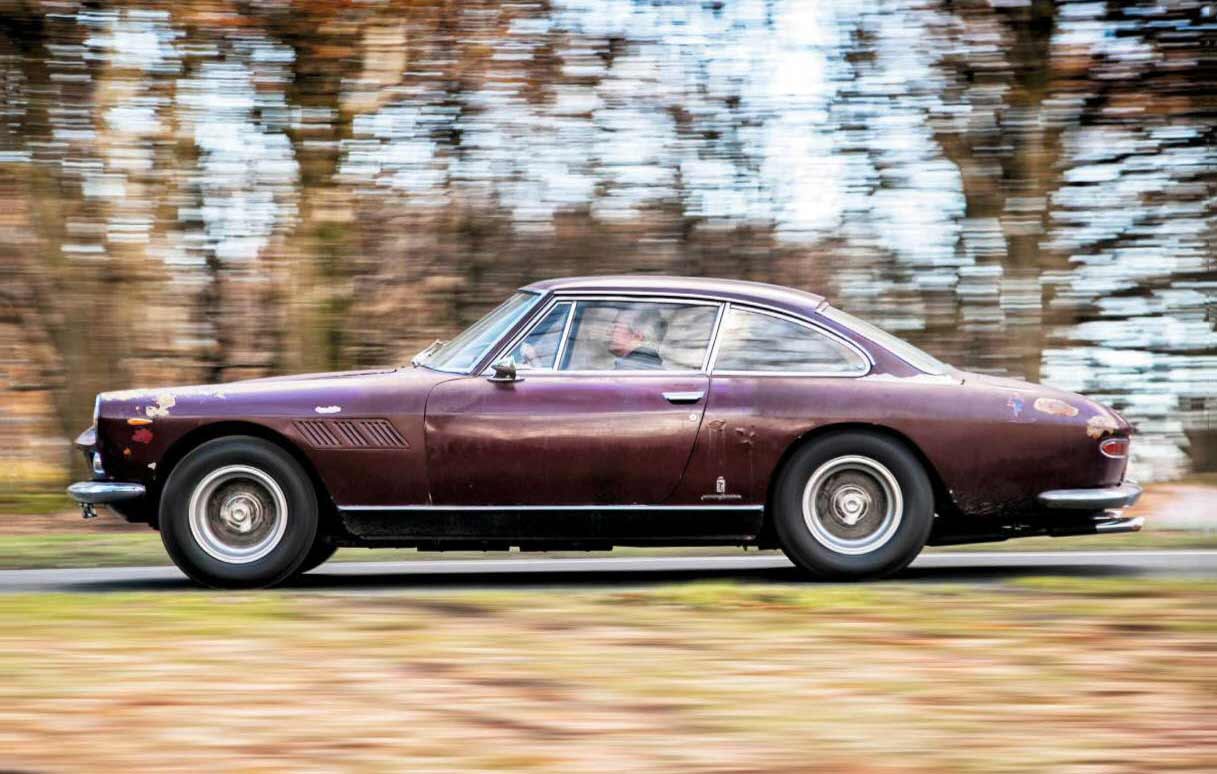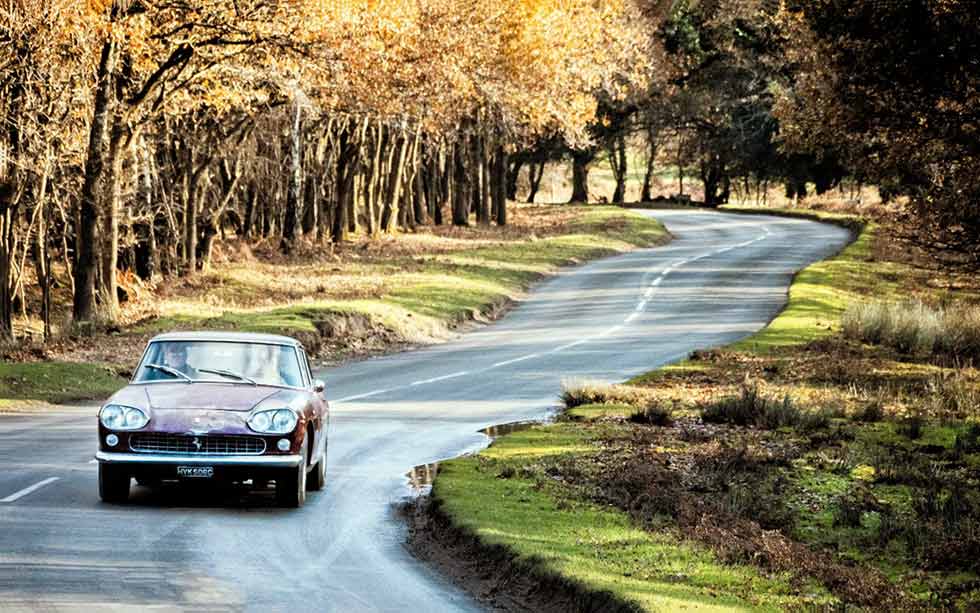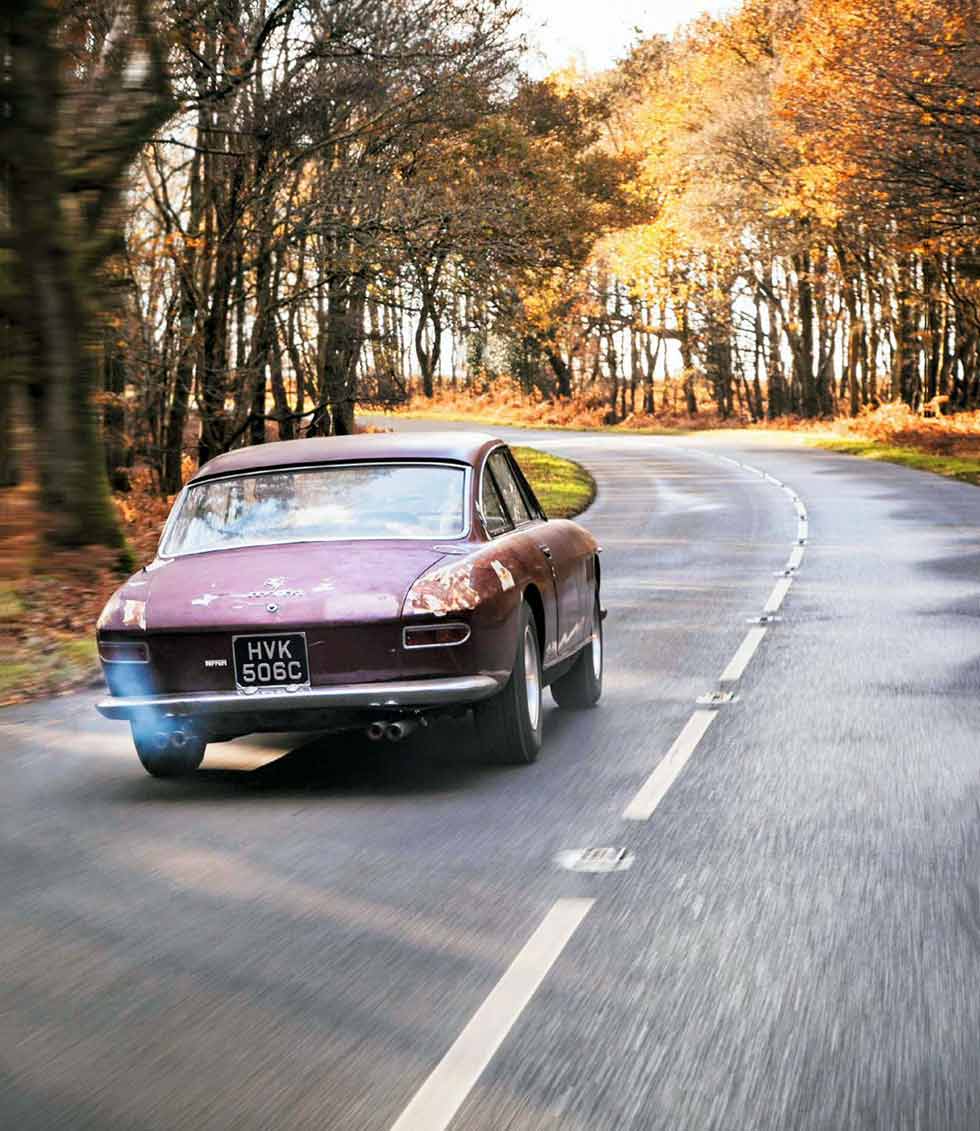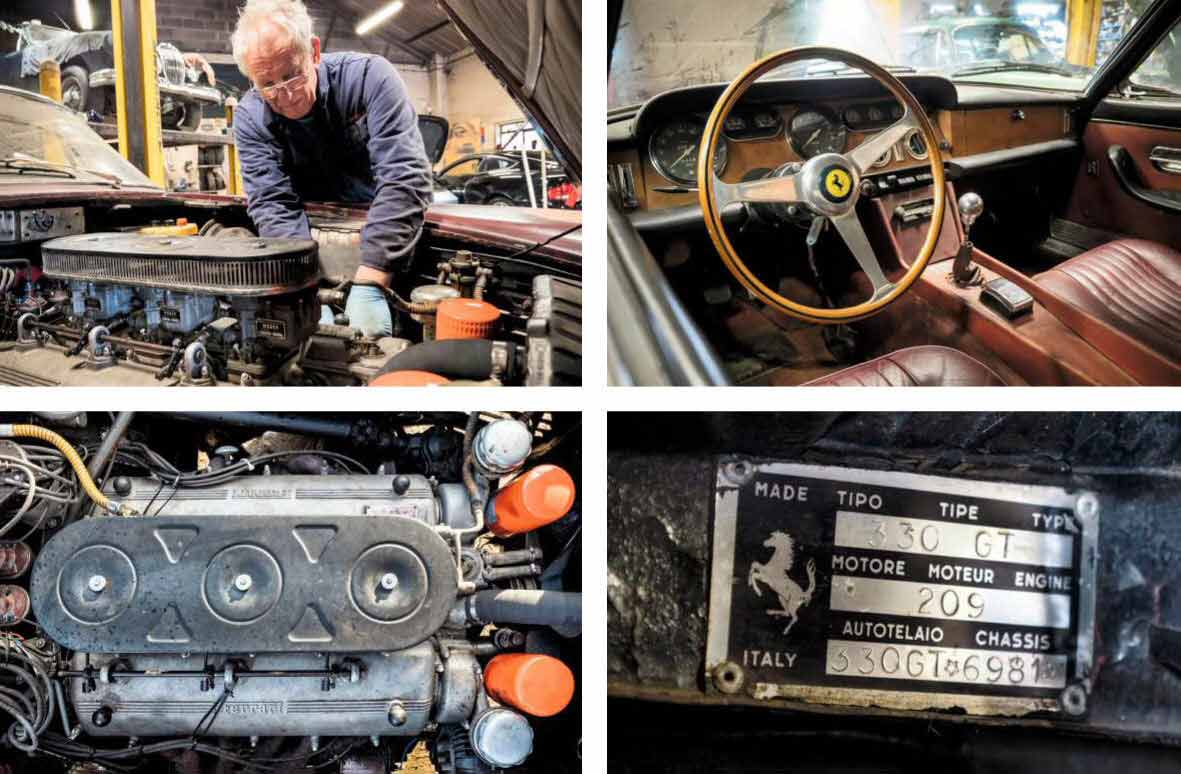
In 1965 Enzo Ferrari presented his latest world champion, John Surtees, with a gift – this Ferrari 330 GT 2+2. Recently rescued, recommission and back on British road it’s time for a drive. Words Dale Drinnon. Photography Martyn Goddard.
Ex-Surtees Ferrari barn find driven. The World-Beater’s Warrior On the road with the Ferrari 330 GT 2+2 that served as John Surtees’ company car when he drove for Enzo.
I shouldn’t even consider doing this yet; mature, sane adults would at least wait until the weather was more trustworthy and the car had some sorting-out miles. Then again, most mature, sane adults aren’t irresistibly drawn to Ferraris that look as though they’ve neither turned a wheel nor had a wash since Mrs Thatcher led Her Majesty’s Loyal Opposition.

When the Ferrari in question is the 330 GT 2+2 presented by Enzo to John Surtees for winning the 1964 Formula One World Championship, towed as a derelict of an American farm, shipped back to the UK and given only the minimum interventions that would make it roadworthy, impatience definitely overrides judgement. The merest hint that a drive might be possible puts me on the owner’s doorstep at first daylight. Besides, the bleak winter backdrop seems fitting for a car freshly snatched from impending oblivion.
So here I am in the driver’s seat, ready to rock, ink still wet on the new MoT and the promised sunshine finally breaking through a chilly morning drizzle. As per the recommended start-up ritual, I rotate the key to the run position, switch on the auxiliary fuel pump until the ticking stops, then spin it over. There’s no ordinary, rhythmic ‘yerk-yerk-yerk’ as the starter turns the engine, more the seamless ‘whurrrrrr’ of a big electric drill. Tip in a bit of throttle when it fires and a very satisfying V12 mini-whoop erupts from the traditional ANSA exhaust. Slide it into first, ease out the clutch against some prudent revs… and I promptly stall it. Twice.
How utterly humiliating. Although why I expected otherwise is a mystery. While things will undoubtedly improve once the technicians are allowed their fettling time, this 330 is a revealing flashback to the day when perpetually motorsport-oriented Ferrari was beginning to take road cars seriously, before Fiat influence had a chance to productionise them. Despite all it’s been through in the intervening half-century, it’s still amazingly similar to how my journalistic hero, the immortal Henry N Manney III, described it for CAR magazine in 1965. On loan from Surtees himself, it had then covered a mere 4000km.
Exactly as Manney reported, for example, the engine gets fluffy at low rpm, and has a light flywheel. Combine those characteristics with a fair old weight of bodywork, luxo seats, electric windows and 90 litres of fuel, and smooth getaways are always going to require more clutch-slipping than you’d expect. In fact, the 330 doesn’t care for pottering about in any form whatsoever; the steering is virtually immovable at launchtype speeds, which makes take-offs even harder if you have to simultaneously manoeuvre in tight quarters, or maybe negotiate traffic through any British village or town.
That’s exacerbated by the famous long-arm, short-leg driving position, for which Surtees fitted a deep-dish steering wheel to compensate. The great man’s modification is long gone, but a steering column extension in its place contributes some help. With the 2+2 cabin and resulting wheelbase-stretch, the 330 GT isn’t petite, either, to the point that dodging leftover puddles on slow B-roads is rather awkward, and the live rear axle does get a touch bouncy over our lovely British washboard tarmac. During his time with the car, Manney found some live axle wheel-hop in rough, fast corners, a possibility that I wouldn’t explore right now for love nor money; on the other hand, the same basic rear suspension was good enough for the GTO…

Taking the clutch pedal full to the floor between the lower gears is mandatory if they’re to engage smoothly, and it needs a fairly stout foot, as do the brakes. The brake pedal is on the low-ish side, but the system stops the car well enough and honestly, a low pedal wasn’t unusual for anyone’s four-wheel discs of the era. And as Signor Ferrari, who piled disc brakes for yonks, might have said – who needs brakes when you got plenty o’ horses?
He wasn’t entirely wrong. Find anything like an open road, where you can get real airflow through the herd of Webers, and the hulking 4.0-litre Colombo-designed V12 is a pure torque factory, pulling slick and clean with endlessly increasing acceleration, like an anvil dropping from the Forth Bridge. Lucky John also bagged the all-synchronised five-speed gearbox from the upcoming two-headlamp Series II model, instead of the usual Laycock overdrive four-speed of the quad-lamp Series I (making this among the 125 ‘interim’ 330 GTs). It’s a honey, especially compared to some of the stubborn semi-crash Ferrari gearboxes of the previous decade, with positive action and strong synchromesh.
Like the best Grand Tourers, the 330 seems to shrink as velocity builds, feeling stable and assured on the highway (live axle notwithstanding) and for its age and life experience, remarkably solid. Front seat accommodations are comfortable and reasonably spacious, after the driver adjusts to his slightly offset pedals, while seating in the rear is quite satisfactory – for a single passenger, that is. For two, I’m not sure it would work at all, unless they knew each other very closely indeed (or wanted to).
Taxi service, however, was never this vehicle’s intended purpose. Its purpose was fast long-distance travel for two, three at a pinch, with style and dash. Dear Henry Manney did precisely that, delivering the car from Monaco to Spa for Surtees, and reckoned that around 90mph proved a safe, sensible clip for cruising the French cross-country N6 Route Nationale, a single carriageway at the time. Perhaps a mite steep for the single carriageways of modern Sussex crowded with local traffic but it gives me something to dream about.
And for John Surtees the 330 likely made an admirable commuter car; when Enzo Ferrari first offered him a choice from the fleet (partly to get Surtees out of a BMW 507), John specifically chose the GT 2+2 because it had the biggest boot. He used the model extensively for travel between European circuits, and had an earlier example as a company car before receiving this one in 1965. During a much later interview he volunteered that he actually liked the previous car better – in the era of largely handcrafted Ferraris, consecutive units easily might have differing personalities. But both of them were less trouble than his Jaguars. Shortly after his 1966 break-up with Enzo, the Ferrari went to a new home in Switzerland, where it suffered minor front-end collision damage, the only documented accident of its career.
Sometime around 1970 it entered the USA by way of legendary Ferrari ex-team driver, North American dealer, distributor and all-round brand advocate, Luigi Chinetti. From there it was sold to a Californian customer, and a further chain of West Coast buyers followed over the ensuing years. Some were long-term, some short, all of them probably decent, caring people, but all equally subject to the whims of the market.
Sadly, that market had decided almost from the moment it landed in my native country that a secondhand 330 GT 2+2 was essentially worth bupkis. Zilch. Nada. As expensive to keep up as a Ferrari sports car, with no racing cred and fussy around town. Less than the sum of its parts, literally, and the quad-headlamp cars were the absolute nadir. I well remember seriously pondering a rumpled but serviceable four-light GT in the Eighties, priced below a VW Golf – and walking away because, well… it had four headlamps. Instead, I ended up buying a Golf – and please, no letters; what can I say except I was young.
During this period many of these particular cars were simply parked and ignored, while others were stripped for parts, including the Surtees 330 which wound up contributing its engine and gearbox to an older, more exotic Ferrari. Still, the car itself remained otherwise whole and complete, passed forward by the faithful as a resto-in-waiting, eventually landing on a farm in the Mid-West. That’s where it was located when Alan Catterall saw it offered for sale on an internet auction site in 2016.
‘I wasn’t necessarily looking for a celebrity Ferrari when I spotted this, and didn’t learn about the Surtees connection until I asked for more information,’ says Alan. ‘I just wanted a 330 GT; a friend had one and I loved it, and the price was acceptable, the chassis number was correct [Ferrari Classiche has since authenticated it] so I decided to take a chance.’ In respect of the car’s provenance and based on the possibility that the original drivetrain might become available in the future, he also chose to initially carry out only a recommissioning, not a restoration, then see how he liked the car and consider his options from there.
Those options should be favourable. Four-lamp GTs remain less valuable than the two-lamp version (sometimes called the ‘single’ headlamp version, just for the sake of added confusion it would seem). But while prices for both are nowhere near the later 330 models with independent rear suspension, they’re now well out of VW territory, Surtees-connected or not. This specimen is also a lot healthier than a glance would imply. The various abrasions and rust patches are mostly superficial; the bright trim is all there and salvageable, the Borranis are unscarred and true, and the interior is time-worn but totally intact.
Maximised as a preservation-class car it would be striking, and total restoration would be a straightforward process. When it comes to recommissioning though, everything generally boils down to how long a car has been inactive. Sitting idle is the cruellest fate for any sort of machinery, from a wristwatch to a locomotive, and this one had evidently been idle forever. In addition Alan wanted to re-use everything humanly possible, for understandable reasons – including money, frankly. He isn’t a collector or investor, just a guy with an intense desire for a Ferrari.
Making it happen fell to Bill Goodall of Newlands Motors, near Eastbourne, who has a considerable history with Ferraris, as a racer as well as a restorer. However, he did not take the assignment without reservations. ‘This isn’t the kind of work we usually do,’ he told me on a visit to his shop several months prior to my drive in the car. ‘We like to be thorough and do things to the best of our abilities from the start, not simply well enough to get the car on the road. No matter how careful you are in a case like this, something always turns into more bother and expense than you anticipated and you feel you’ve let your client down.’
What finally convinced Bill to come on board was refreshingly human. ‘I liked Alan, liked his enthusiasm, and I knew John Surtees and liked what Alan planned to do with the car.’ These plans went back to well before John’s passing in March 2017 and involved promotional appearances around the country with the Surtees Ferrari in support of the Henry Surtees Foundation and the Sporting Bears charity, of which John was the founding patron. Such is still Alan’s intent, and the car attended some 2017 events as a rolling chassis and had the distinction of a week on display in the rotunda of the Royal Automobile Club.
As inevitably happens, Bill was both right and wrong in his worries and delays came from the unlikeliest of reasons. Donor cars are plentiful, by Ferrari standards, and sourcing a drivetrain primarily amounted to finding the appropriate gearbox. But a new brake booster gave no boost and had to be re-ordered, and the fuel tank that came with the car and contained decent petrol, looked fine from the outside, issued no debris or contamination from the inside, but then started leaking at the last minute. Missing elements of the external clutch mechanism were no longer available and had to be individually fabricated. Death by a thousand cuts is never painless.
The current state of affairs is that the propshaft needs to go out for another balance, and Bill thinks the front calipers may be sticking and wants to rebuild them again. Personally, I didn’t have any complaints during the miles I spent with the car, so maybe a couple of heat cycles were all they lacked. From our first conversation, Bill had predicted grief from the carburettors, too, ‘Those give problems every time, and it takes a lot of driving and tweaking to sort them out.’ I’m seizing that as an excuse for a second outing once the aforementioned fettling is done.
On the positive and extremely relieving side, after several fuses were replaced with the size they should have been, the electrics have worked splendidly, including the power windows. In other good news the full ANSA exhaust was of a surprisingly recent vintage, as were the suspension bushings, suggesting that some kind soul in the past, bless ’em, had good intentions. Bill agrees that this 330 is, at its heart, worth all the effort. ‘It’s a good survivor, no crash damage, no rust; the outer sills are fine and we certainly don’t see that often.’
Of course, lots of testing and fine tuning lies ahead, but Alan is OK with that; he understands every old car is an ongoing experiment and looks forward to spring and devoting plenty of miles to honing the results. In the breaks we take during the day of my drive the subject of a possible restoration even comes up a time or two. Back at Newlands Motors, as Alan starts up the inclined ramp leading into the shop, the engine whoops and a pair of neat, black stripes trail behind the rear tyres.
He shuts of inside the door and exits the Ferrari with a sheepish but extremely happy grin on his face. Yep, those carbs obviously need more work; I mean, surely nothing but sticky carbs could cause a thing like that…
Arrivederci, Enzo. How Surtees came to leave Ferrari (and the Ferrari to leave Surtees)
Enzo Ferrari was said to have a soft spot for John Surtees, but that didn’t exempt Surtees from the infamous and eternal politics of Scuderia Ferrari.
John had particular difficulties with racing director Eugenio Dragoni, who he believed to favour the Italian drivers – and Dragoni had form, having already nudged world champion Phil Hill out of the door. The matter turned critical at Le Mans in 1966, where Dragoni promoted Ludovico Scariotti to lead driver, claiming Surtees was unit from injuries suffered in his horrible Lola T70 crash of the previous September. Surtees felt it no coincidence that Scariotti was Gianni Agnelli’s nephew.
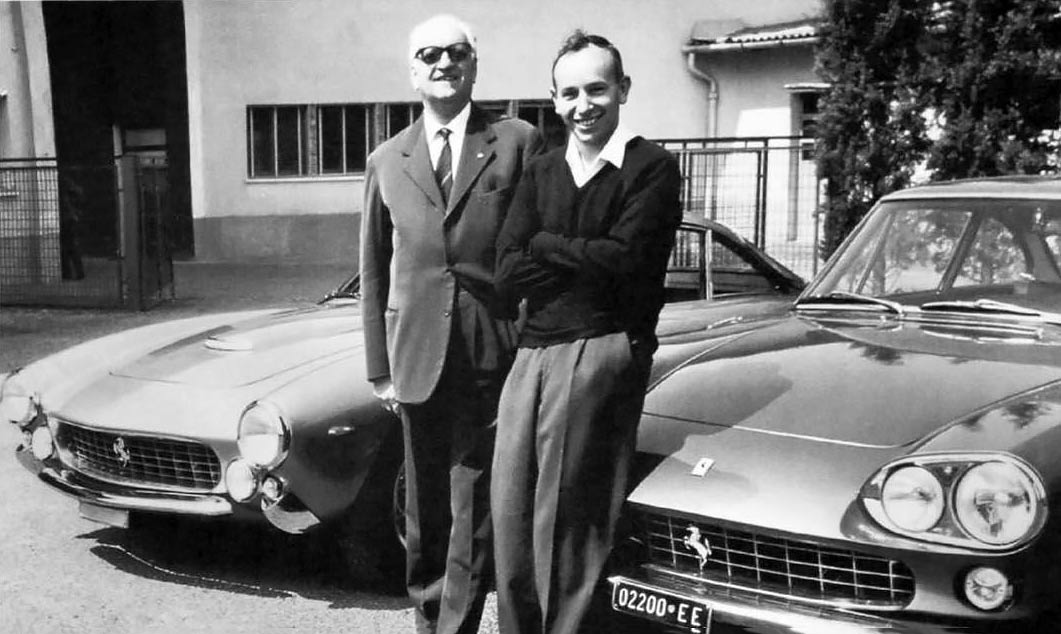
Surtees was incandescent at the news; as he put it, ‘I jumped into my 330 GT road car and drove flat out, then and there, to Maranello, and went straight to see the Old Man.’ Neither of those two forceful individuals was of a mood to relinquish any ground. After what was a brief and no doubt exceptionally spirited discussion, Surtees left the works and the employment of Enzo Ferrari, and one can but speculate about the noises and tyre marks produced by the 330 on that occasion.
In short order, Surtees went to Cooper-Maserati for Formula One, finishing an outstanding second in season points. His 330 GT went to a new owner in Switzerland.
Tech and photos Surtees Ferrari 330GT 2+2
TECHNICAL DATA FILE SPECIFICATIONS 1965 Ferrari 330 GT 2+2
Engine 3967cc V12, sohc, three Weber 40 DCZ/6 twin-choke downdraught carburettors
Power 300bhp @ 6600rpm; 288lb ft @ 5000rpm / DIN
Transmission Five-speed manual, all-synchro, rear-wheel drive
Brakes Discs all round
Suspension Front: independent, double wishbones, coil springs, telescopic dampers, anti-roll bar. Rear: live axle, twin radius arms, semi-elliptic springs, plus coil springs over telescopic dampers
Steering Worm and sector
Weight 1380kg dry (3036lb)
Performance Top speed: 151mph; 0-60mph 6.7sec
Fuel consumption 15mpg
Cost new 6,500,000 lire (approx £3727)
CC Price Guide £85,000-£240,000
‘This 330 is, at its heart, worth all the effort. It’s a good survivor, no rust’
‘It has been given only the minimum interventions to make it roadworthy’
